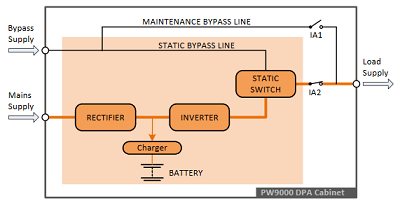The prospect of ‘doubling up’ on cost and footprint has in the past put data centre managers off redundant UPS solutions.
However, while this may have been true a few years ago, it is no longer the case. Conversely, today’s parallel redundant UPS systems offer major benefits in cost and space savings, efficiency, flexibility and, perhaps most of all, power availability – an important factor given that data centres are sucking harder on mains supply at a time when the National Grid is running low.
In our own experience, just a decade ago, only 10 percent of three-phase UPSs were parallel redundant systems. But today, even for smaller rated three-phase systems, parallel redundancy now accounts for more than 70 percent of installations. For new UPS specifications, traditional stand-alone systems – with their inherent single points of failure – are increasingly outmoded.
The majority of data centres are migrating to parallel redundant UPS systems, providing a minimum of one module over and above that required for capacity and ensuring continuous support of the load if any one module shuts down.
Driving change
What has happened to transform the way UPS systems are configured? There are two major factors: changes in the business landscape, and changes in UPS technology.
Firstly, reliance on critical IT and communication systems is no longer the preserve of major corporations. Today, with the proliferation of online transactions and globalisation, thousands of SMEs are also highly dependent on computers and telecoms for survival and are fuelling the critical and competitive data centre market. With the freedom and demand for 24/7 trading, power continuity around-the-clock is essential: in highly price-sensitive markets, and with customers conditioned to instant availability, even a minor interruption to business can cause a major loss of revenue.
Secondly, UPS technology has evolved, making the installation of a parallel redundant UPS configuration practical and affordable, as well as desirable. For example, the development of transformerless UPSs and Decentralised Parallel Architecture has significantly reduced their size compared with free-standing legacy systems. By comparison, today’s rack format modular UPSs take up only 25 percent of the floor space, and vertically scalable modules mean that additional capacity for redundancy or load upgrades can be achieved without any footprint penalty, a major benefit in light of the burgeoning space and capacity crunch concerning today’s data centre operators. Further, doubling capacity does not mean doubling expenditure – an N+1 configuration (compared with traditional 1+1) means that extra modules can be installed in an existing cabinet at a fraction of the cost of an additional stand-alone unit.
Redundant solutions
When specifying a UPS system, it can be difficult to predict what the final load is going to be, particularly given the exponential growth of IT power and data storage needs, so installations are often oversized to provide contingency. While this may ensure sufficient UPS capacity, it means inefficient operation and poor cost control. By choosing a parallel redundant solution to increase availability, users also gain the benefit of ‘scalability’. Modularity gives users the flexibility to correctly size the system from day one and, when loads increase, additional UPS units can be inserted cost-effectively and without downtime.
Transportability is another major plus point, since ‘hot-swappable’ modules can be transferred from one floor or server suite to another or even to a different site, providing capacity and redundancy when and where it is most needed – a welcome boon for flexibility and reconfiguration.
To illustrate these points, we can compare a single stand-alone non-redundant 100kVA UPS solution with a parallel redundant 3 x 50kVA UPS rack-mounted solution. While the latter may carry a price premium, the cost-benefit is quickly apparent. The modular configuration provides redundancy if one of the units fails, and spare ways can accommodate an increase in capacity in affordable, incremental steps without interruption to the critical load. The stand-alone system provides no redundancy, and the addition of a second parallel 100kVA unit to increase capacity (‘doubling up’ in the old sense) would be more costly, take up twice the space, and would also incur downtime during installation.
Power failure?
The rapid growth of web-based commerce, data storage and complex applications has dramatically increased the number of IT loads falling into the ‘critical’ category. This is outstripping the level of protection some UPS systems were originally designed for and consequently failing to provide any form of redundancy. While major investments have been made in expanding and upgrading IT systems, many are still reliant on single stand-alone UPSs. These are typically incorrectly sized for today’s increased loads. A ten year-old legacy system is effectively a box of aging electronics which despite regular maintenance could represent a potential risk of failure.
Business functionality is increasingly driven by power-dependent, sensitive equipment, requiring a more stable and reliable power source than is generally offered by the utility mains supply. Rising consumption, coupled with an aging power infrastructure and predicted shortfalls, means that UK businesses should be prepared for a less reliable electricity supply, harmful spikes and potential blackouts. With a hotter than average summer well under way, power and cooling demands are putting greater strain on the increasingly fragile utility mains.




